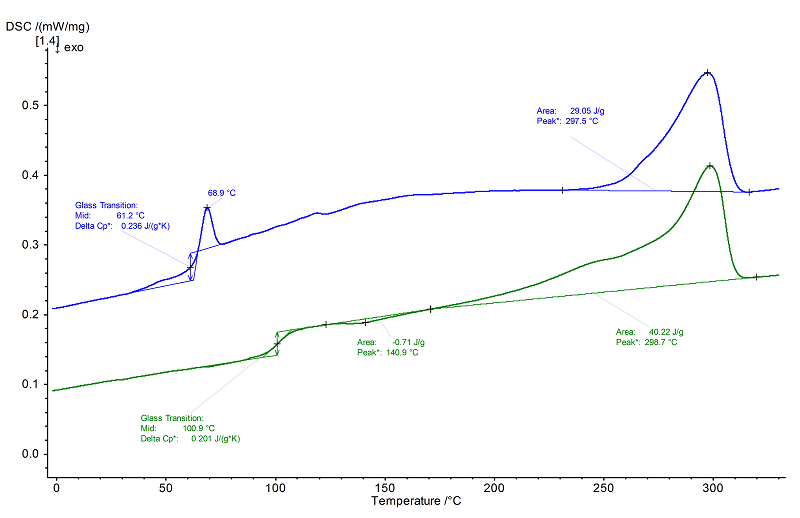PA6/6T: Polyamide 6/6T
- Short Name
- PA6/6T
- Name
- Polyamide 6/6T
- Group
- HTRTP - High-Temperature Resistant Thermoplastics
- General Properties
- Chemical Formula
- Structural Formula
-

Properties
- Glass Transition Temperature
- 60 to 100 °C
- Melting Temperature
- 250 to 300 °C
- Melting Enthalpy
- - J/g
- Decomposition Temperature
- 460 to 480 °C
- Young's Modulus
- 3500 to 3600 MPa
- Coefficient of Linear Thermal Expansion
- 70 *10¯6/K
- Specific Heat Capacity
- - J/(g*K)
- Thermal Conductivity
- - W/(m*K)
- Density
- 1.18 g/cm³
- Morphology
- Semi-crystalline thermoplastic
- General properties
- High mechanical stability. High chemical resistance. High toughness in the cold. Higher temperature resistance than PA6 or PA6.6
- Processing
- Injection molding
- Applications
- Electrical engineering/electronics (gear wheels, plug connectors…). Axes. Fishing equipment
Internet Links
NETZSCH Measurements
- Instrument
- DSC 204 F1 Phoenix®
- Sample Mass
- 12.29 mg
- Isothermal Phase
- 5 min
- Heating/Colling Rates
- 10 K/min
- Crucible
- Al, pierced
- Atmosphere
- N2 (50 ml/min)

Evaluation
The large relaxation peak overlapping the glass transition (midpoint: 61°C) in the 1st heating (blue) indicates that this polymer sample had been tempered at 40/50°C or had been stored in that temperature range for a long period of time.
Due to the elimination of water (broad peak from approx. 90°C to 180°C) during the 1st heating, the glass transition shifted to 101°C (midpoint) in the 2nd heating (green).
In the 2nd heating (green), the sample melting began after a small exothermal post-crystallization (peak: 141°C) following the glass transition; the temperature of the main peak was 299°C. The corresponding melting enthalpy amounted to 40 J/g.
In the first heating, the total melting enthalpy was 29 J/g and thus a bit lower than in the 2nd heating, indicating that additional crystallization had occurred during the intervening cooling segment. Nevertheless, the melting temperature (peak temperature) of 298°C was similar to that in the 2nd heating.
Due to the elimination of water (broad peak from approx. 90°C to 180°C) during the 1st heating, the glass transition shifted to 101°C (midpoint) in the 2nd heating (green).
In the 2nd heating (green), the sample melting began after a small exothermal post-crystallization (peak: 141°C) following the glass transition; the temperature of the main peak was 299°C. The corresponding melting enthalpy amounted to 40 J/g.
In the first heating, the total melting enthalpy was 29 J/g and thus a bit lower than in the 2nd heating, indicating that additional crystallization had occurred during the intervening cooling segment. Nevertheless, the melting temperature (peak temperature) of 298°C was similar to that in the 2nd heating.